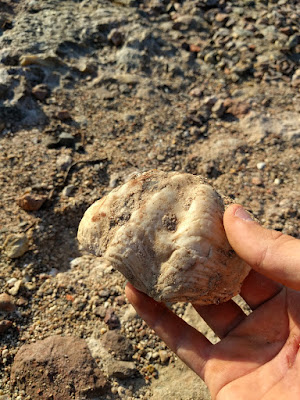T. maxima, right and T. squamosina, left
Snorkeling in the area around Eilat, I have been lucky to observe many live Tridacna of all three species I came to search for, and also many fossil specimens literally laying around on the ground. The live Tridacna include T. maxima (the most common), T. squamosa (less common), and T. squamosina (the rarest).
The giant clams' reef environment
The reefs here are full of live hard coral and many juvenile clams, though large ones more than half a foot are harder to find. Yet my worries about not being able to find live specimens of T. squamosina appear to be without merit. I found specimens even directly offshore of heavily trafficked tourist beaches, which is encouraging as it means Tridcana is able to recruit and grow despite regular human disturbance. Though under threat, T. squamosina is holding on in the Eilat area. I intend to sample these live individuals with a syringe, which I can use as a standard to compare to the shell chemistry I see in the fossils.
A small, happy T. squamosa #happyasaclam
Walking up and down the road, I have found many likely fossil specimens of Tridacna laying in piles of excavated "reef rock" excavated during construction of IUI, the neighboring aquarium and the road itself. The reef rock is formed from the assorted rubble of the reef mixed with pebbles and cobbles of igneous rock sourced from on land.
This morning, I was able to chip out several specimens of T. maxima from a shelf of 5 thousand year old shelf of reef rock known as Tur Yam. These specimens will serve as the ancient baseline of Tridacna growth in the Eilat area before industrialization and population growth greatly increased human influence on the chemistry of the Red Sea.
Location of fossil site Tur Yam in comparison to IUI
This morning, I was able to chip out several specimens of T. maxima from a shelf of 5 thousand year old shelf of reef rock known as Tur Yam. These specimens will serve as the ancient baseline of Tridacna growth in the Eilat area before industrialization and population growth greatly increased human influence on the chemistry of the Red Sea.
A shell of T. maxima, in and out of the rock!






No comments:
Post a Comment